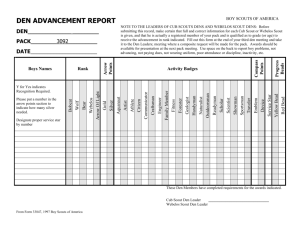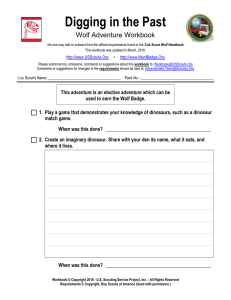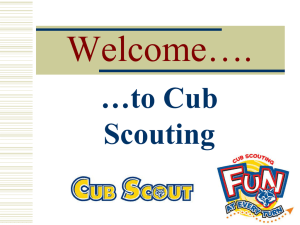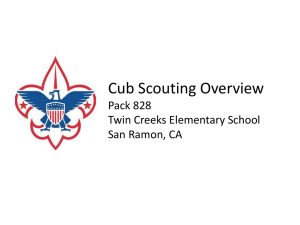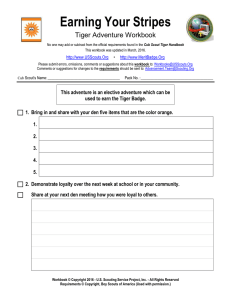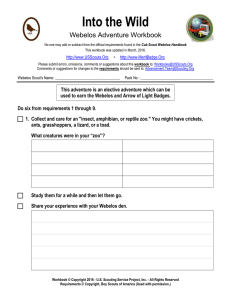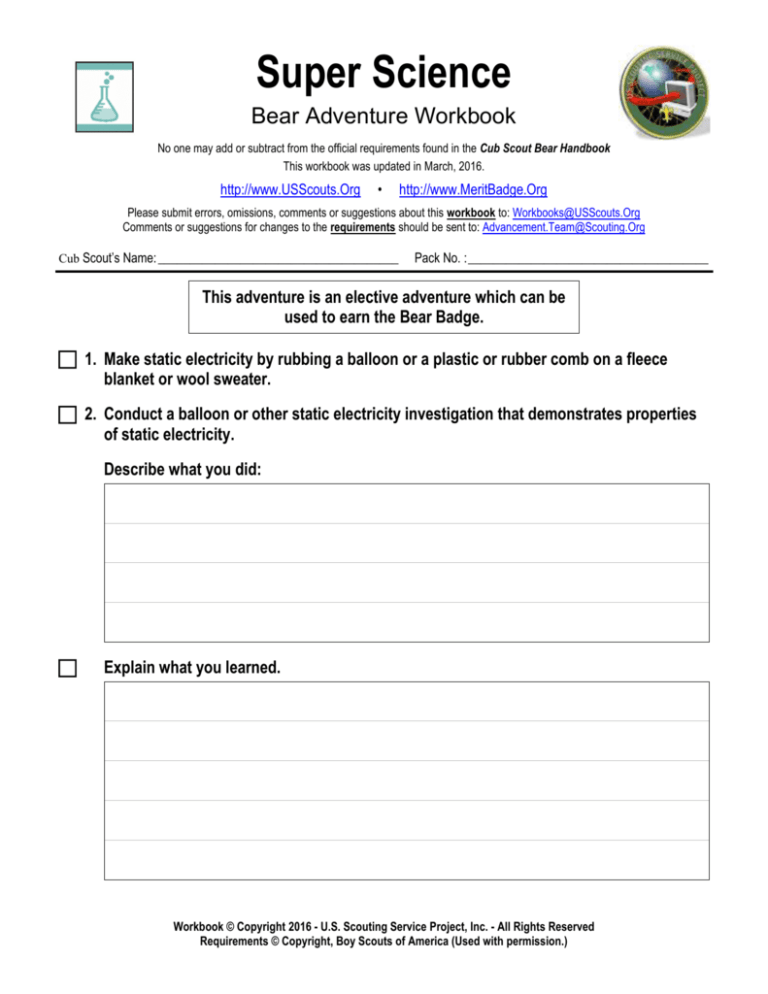
Super Science
Bear Adventure Workbook
No one may add or subtract from the official requirements found in the Cub Scout Bear Handbook
This workbook was updated in March, 2016.
http://www.USScouts.Org
•
http://www.MeritBadge.Org
Please submit errors, omissions, comments or suggestions about this workbook to: Workbooks@USScouts.Org
Comments or suggestions for changes to the requirements should be sent to: Advancement.Team@Scouting.Org
Cub Scout’s Name: ______________________________________
Pack No. : ______________________________________
This adventure is an elective adventure which can be
used to earn the Bear Badge.
1. Make static electricity by rubbing a balloon or a plastic or rubber comb on a fleece
blanket or wool sweater.
2. Conduct a balloon or other static electricity investigation that demonstrates properties
of static electricity.
Describe what you did:
Explain what you learned.
Workbook © Copyright 2016 - U.S. Scouting Service Project, Inc. - All Rights Reserved
Requirements © Copyright, Boy Scouts of America (Used with permission.)
Super Science
Cub Scout's Name: ________________________
3. Conduct one other static electricity investigation.
What did you investigate? ____________________________________________________
Describe what you did:
Explain what you learned.
4. Do a sink-or-float investigation.
Describe what you did:
Super Science Workbook
Page 2 of 5
Super Science
Cub Scout's Name: ________________________
Explain what you learned.
5. Do a color-morphing investigation.
Describe what you did:
Explain what you learned.
Super Science Workbook
Page 3 of 5
Super Science
Cub Scout's Name: ________________________
6. Do a color-layering investigation.
Describe what you did:
Explain what you learned.
Super Science Workbook
Page 4 of 5
Important excerpts from the Guide To Advancement - 2015, No. 33088 (SKU-620573)
[1.0.0.0] — Introduction
The current edition of the Guide to Advancement is the official source for administering advancement in all Boy Scouts of America programs: Cub
Scouting, Boy Scouting, Varsity Scouting, Venturing, and Sea Scouts. It replaces any previous BSA advancement manuals and previous editions of
the Guide to Advancement.
[Page 4, and 5.0.1.4] — Policy on Unauthorized Changes to Advancement Program
No council, committee, district, unit, or individual has the authority to add to, or subtract from, advancement requirements. There are limited
exceptions relating only to youth members with special needs. For details see section 10, “Advancement for Members With Special Needs”.
[Page 4] — The “Guide to Safe Scouting” Applies
Policies and procedures outlined in the Guide to Safe Scouting apply to all BSA activities, including those related to advancement and Eagle Scout
service projects.
[4.1.0.3] — Who Approves Cub Scout Advancement?
A key responsibility for den leaders is to implement the den meeting plans as outlined in the four den leader guides shown within this topic. For Tiger
through Bear ranks, if the activity is completed outside of the den meeting, the parent, adult partner, or another trusted adult should sign in the boy’s
handbook, indicating the Cub Scout has done his best to complete the requirement. The den leader then approves that requirement after consultation
with the family or the boy to confirm completion. If the requirement is completed in a den meeting, the den leader signs in both places. Den leaders
may, however, ask an assistant or parent who helps at meetings to play the role of “Akela” and assist with the approvals. For Webelos and Arrow of
Light ranks, the den leader signs for approval of all requirements, unless the den leader delegates this responsibility.
[4.1.0.4] — “Do Your Best”
Cub Scouts—even those of the same age—may have very different developmental timetables. For this reason, advancement performance in Cub
Scouting is centered on its motto: “Do Your Best.” When a boy has done this—his very best—then regardless of the requirements for any rank or
award, it is enough; accomplishment is noted. This is why den leaders, assistants, and parents or guardians are involved in approvals. Generally they
know if effort put forth is really the Cub Scout’s best.
When a boy completes advancement, he should be congratulated immediately and publicly. And though badges of rank should be reserved for the
next pack meeting, it is best to present items such as belt loops and pins soon after they have been earned. If it is possible for the pack to report and
purchase these awards quickly, they could be presented at a den meeting, rather than waiting for a pack meeting. If presented at den meetings, the
accompanying pocket certificates can be used in a ceremony at a subsequent pack meeting—or vice versa with the pocket certificates at a den
meeting. However this is done, it is important to note that advancement is an individual process, not dependent on the work or progress of others.
Awards should not be withheld for group recognition. Likewise, a boy should not be presented with recognition he has not earned simply so that he will
“not feel left out.”
In the same spirit as “Do Your Best,” if a boy is close to earning a badge of rank when the school year ends, the pack committee, in consultation with
the den leader and the Cub Scout’s parent or guardian, may allow him a few weeks to complete the badge before going on to the next rank. Earning it
will give him added incentive to continue in Scouting and carry on and tackle the next rank.
Additional notes of interest:
Cub Scouts may complete requirements in a family, den, pack, school, or community environment.
“Akela” (Pronounced “Ah-KAY-la”) — Akela (Ah-KAY-la) is a title of respect used in Cub Scouting—any good leader is
Akela, who is also the leader and guide for Cub Scouts on the advancement trail.

